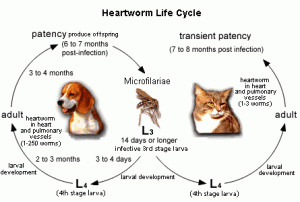Hot Issue – Heartworm in dogs
Heartworm in Dogs
This Hot issue has been sparked by rumors that Heartworm is spreading round the world and has entered South Africa
Heartworm is cause by a worm known as Dirofilaria immitis and thus the disease is sometimes called Dirofiliasis.
Heartworms are worms that live in the pulmonary artery and sometimes if there are many worms, inside the heart itself. They affect primarily dogs but ferrets, cats and wild animals are also susceptible. Medium to large dogs of 3-8 years are mostly affected. Heartworms are found in countries with temperate, subtropical and tropical weather. Their main areas of distribution are the Unites States, Canada, Southern Europe and areas in South America.(1)(4) However they have also been found in Mozambique, sparking concerns of them spreading into South Africa. No cases have been found in South Africa.
They are spread by mosquitoes which feed on a animal that is carrying Heartworm stage 1 larvae. Larvae are sucked up into the mosquito where they live and develop into a second and third stage. The third stage is ready to move back into the dog, and when the mosquito bites it leaves the mosquito, and moves onto the skin and burrows in through the bite wound. They stay inside the skin and molt to a fourth and fifth stage after 2-3 months. Then they move out the skin, into the body and end up in the pulmonary artery, which is the large artery leaving the heart that goes to the lungs. They grow to adult sizes of between 15 and 25cm a worm. They live in the artery and when there are many of them in the right ventricle. Six to seven months later the female produces the larval stages that can reinfect a mosquito, known as microfilariae.
How sick an animal gets depends on worm numbers and how the animal’s body reacts to the worms, how long they have been there and also how active the dog is. Very active dogs such as hunting dogs can get a lot sicker than sedentary apartment dogs. Live worms cause thickening and scarring of the wall of the artery. When worms die, the animal’s body can also have a nasty reaction to the dead worm floating in the blood, causing lung damage. Congestive heart failure and kidney damage may occur. Thrombosis due to clots and worms stuck in small arteries can occur especially in the lungs. Cats and ferrets are more likely to die from lung disease.
Clinical Signs
Clinical signs in dogs include coughing, exercise intolerance, poor body condition, difficulty in breathing, cyanosis (a blue colour of the gums due to too little oxygen), coughing up blood, fainting spells, nose bleeds and water accumulation in the belly. Cats show weight loss, vomiting, difficulty breathing, coughing, lethargy anorexia. Many of the same signs may be seen with feline asthma.
Diagnosis
Vets will diagnose a Heartworm infection using a blood test (dogs only test positive 5-7 months after an infection) a physical exam, X rays and echocardiography to check for enlargement of the heart, checking for protein and blood pigment (in severe cases the urine is red) in the urine , a blood count for anemia, and white cell counts, blood protein count and platelet count which may be low in severe disease, Disease is classed as stage 1-4 with 1 being the mildest and 4 the most severe (collapsed animals in respiratory distress who need surgery to survive) . In cats , the blood test is not as sensitive or specific as in dogs, as cats can show up as positive long after the worms have died.
Treatment
Heartworm is completely preventable with regular monthly treatments of drugs known as Macrolides or Pyrantel pamoate (a wormer). Macrolides include Ivermectin, Milbemycin oxime (milbemex), Selamectin and Moxidectin. Milbemycin may cause shock if there are many microfilariae and thus is not recommended. Ivermectin is contraindicated in all collies and cross collies.
[ad#Commission Junction – Total pet supply]
If dogs are infected with the adult worms, then a drug that kills the adults known as Melarsamine dihydrochloride is used. The injection is painful and can cause swelling and scarring. Dogs with many worms may also have a shock reaction to the dead worms in their circulation anytime from a few days up to 6 weeks after the injection. Some vets split the drug into 3 separate injections for this reason and some vets treat with ivermectin for 1-6 months before using Melarsamine to kill all the immature worms first and thus minimize the shock reaction. Dogs are not allowed to exercise at all for 4-6 weeks after treatment and high risk cases are admitted into hospital, treated with cortisone, and heparin for a week before starting treatment. Dogs may also develop pulmonary embolism, coughing up blood, difficulty with breathing, rapid pulse rate, anorexia and fever after being treated. Cats cannot be treated with this drug and have to be treated with cortisone, fluids and a monthly preventative.
If the dogs have got heart failure then they also need to be treated with diuretics, ACE inhibitors and fed a low sodium diet. Digoxin(Lanoxin) is not advised at all. After treatement maintain the dogs on ivermectin monthly for 2 years. Dogs should have a blood test annually.




Leave a Reply
You must be logged in to post a comment.